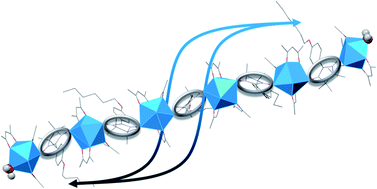Single-chain magnet behavior in a finite linear hexanuclear molecule†
Abstract
The careful monitoring of crystallization conditions of a mixture made of a TbIII building block and a substituted nitronyl-nitroxide that typically provides infinite coordination polymers (chains), affords a remarkably stable linear hexanuclear molecule made of six TbIII ions and five NIT radicals. The hexanuclear units are double-bridged by water molecules but ab initio calculations demonstrate that this bridge is inefficient in mediating any magnetic interaction other than a small dipolar antiferromagnetic coupling. Surprisingly the hexanuclears, despite being finite molecules, show a single-chain magnet (SCM) behavior. This results in a magnetic hysteresis at low temperature whose coercive field is almost doubled when compared to the chains. We thus demonstrate that finite linear molecules can display SCM magnetic relaxation, which is a strong asset for molecular data storage purposes because 1D magnetic relaxation is more robust than the relaxation mechanisms observed in single-molecule magnets (SMMs) where under-barrier magnetic relaxation can operate.



 Please wait while we load your content...
Please wait while we load your content...